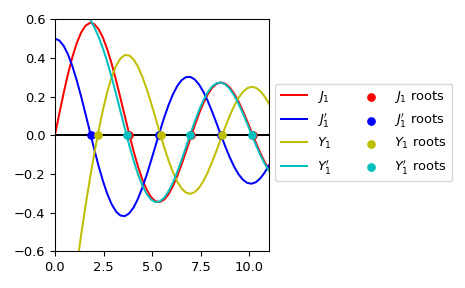本文简要介绍 python 语言中 scipy.special.jnyn_zeros 的用法。
用法:
scipy.special.jnyn_zeros(n, nt)#计算贝塞尔函数 Jn(x)、Jn’(x)、Yn(x) 和 Yn’(x) 的 nt 零点。
返回 4 个长度的数组nt,对应第一个nt分别为 Jn(x)、Jn’(x)、Yn(x) 和 Yn’(x) 的零点。零按升序返回。
- n: int
贝塞尔函数的阶数
- nt: int
要计算的零数 (<=1200)
- Jn: ndarray
Jn 的前 nt 个零
- Jnp: ndarray
Jn' 的前 nt 个零
- Yn: ndarray
Yn 的前 nt 个零
- Ynp: ndarray
Yn' 的前 nt 个零
参数 ::
返回 ::
参考:
[1]张善杰和金建明。 “特殊函数的计算”,John Wiley and Sons,1996 年,第 5 章。https://people.sc.fsu.edu/~jburkardt/f77_src/special_functions/special_functions.html
例子:
计算 、 、 和 的前三个根。
>>> from scipy.special import jnyn_zeros >>> jn_roots, jnp_roots, yn_roots, ynp_roots = jnyn_zeros(1, 3) >>> jn_roots, yn_roots (array([ 3.83170597, 7.01558667, 10.17346814]), array([2.19714133, 5.42968104, 8.59600587]))绘制 、 、 、 及其根。
>>> import numpy as np >>> import matplotlib.pyplot as plt >>> from scipy.special import jnyn_zeros, jvp, jn, yvp, yn >>> jn_roots, jnp_roots, yn_roots, ynp_roots = jnyn_zeros(1, 3) >>> fig, ax = plt.subplots() >>> xmax= 11 >>> x = np.linspace(0, xmax) >>> x[0] += 1e-15 >>> ax.plot(x, jn(1, x), label=r"$J_1$", c='r') >>> ax.plot(x, jvp(1, x, 1), label=r"$J_1'$", c='b') >>> ax.plot(x, yn(1, x), label=r"$Y_1$", c='y') >>> ax.plot(x, yvp(1, x, 1), label=r"$Y_1'$", c='c') >>> zeros = np.zeros((3, )) >>> ax.scatter(jn_roots, zeros, s=30, c='r', zorder=5, ... label=r"$J_1$ roots") >>> ax.scatter(jnp_roots, zeros, s=30, c='b', zorder=5, ... label=r"$J_1'$ roots") >>> ax.scatter(yn_roots, zeros, s=30, c='y', zorder=5, ... label=r"$Y_1$ roots") >>> ax.scatter(ynp_roots, zeros, s=30, c='c', zorder=5, ... label=r"$Y_1'$ roots") >>> ax.hlines(0, 0, xmax, color='k') >>> ax.set_ylim(-0.6, 0.6) >>> ax.set_xlim(0, xmax) >>> ax.legend(ncol=2, bbox_to_anchor=(1., 0.75)) >>> plt.tight_layout() >>> plt.show()
相关用法
- Python SciPy special.jn_zeros用法及代码示例
- Python SciPy special.jnp_zeros用法及代码示例
- Python SciPy special.j1用法及代码示例
- Python SciPy special.jacobi用法及代码示例
- Python SciPy special.j0用法及代码示例
- Python SciPy special.jv用法及代码示例
- Python SciPy special.jvp用法及代码示例
- Python SciPy special.jve用法及代码示例
- Python SciPy special.exp1用法及代码示例
- Python SciPy special.expn用法及代码示例
- Python SciPy special.ncfdtri用法及代码示例
- Python SciPy special.gamma用法及代码示例
- Python SciPy special.y1用法及代码示例
- Python SciPy special.y0用法及代码示例
- Python SciPy special.ellip_harm_2用法及代码示例
- Python SciPy special.i1e用法及代码示例
- Python SciPy special.smirnovi用法及代码示例
- Python SciPy special.ker用法及代码示例
- Python SciPy special.ynp_zeros用法及代码示例
- Python SciPy special.k0e用法及代码示例
- Python SciPy special.logsumexp用法及代码示例
- Python SciPy special.expit用法及代码示例
- Python SciPy special.polygamma用法及代码示例
- Python SciPy special.nbdtrik用法及代码示例
- Python SciPy special.nbdtrin用法及代码示例
注:本文由纯净天空筛选整理自scipy.org大神的英文原创作品 scipy.special.jnyn_zeros。非经特殊声明,原始代码版权归原作者所有,本译文未经允许或授权,请勿转载或复制。
